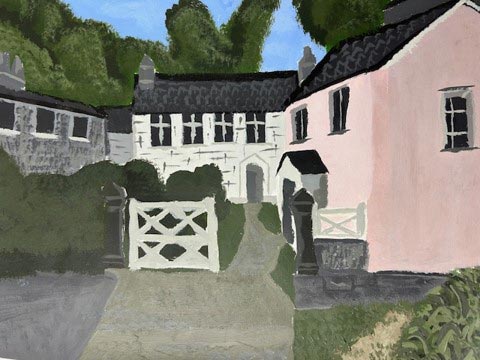On this page you will find:
- Energy Overview
- Key Facts and Figures
- Sustaining the Landscape
- Management Influences and Forces for Change
- Policies and Priorities
Energy Overview
The power of the sun or solar energy is a fundamental driver for many natural processes on earth. Due to its geographical location and Island status, the Isle of Wight AONB benefits from long sunshine hours, extended growing seasons and a comparably warm climate. The good sunshine hours, a mix of farmland and woodland for growing biofuels, coastal locations offering tidal flows, sea breezes and the underlying geology of the Isle of Wight AONB’s landscapes offer an array of resources that can be used to produce energy.

Many of the communities within the Isle of Wight AONB are ‘off the grid’ for mains gas and are reliant on electricity, solid fuel, LPG or oil for their heating needs, which can be considerably more expensive. In fact, many households are considered to be suffering from ‘Fuel Poverty’ as over 10% of their income is spent on fuel. Additionally, a specific problem in rural areas is that many of the properties are what are classed as ‘hard to treat’ meaning that they do not lend themselves to simple insulation measures.
National Planning Policy (NPPF 2023)8 clearly states there should be a presumption against major development within or affecting the AONB. The intimate and fragmented nature of the Isle of Wight AONB, the complexity of its landscapes and diversity of their character, makes the area sensitive to change and reduces its ability to accommodate large scale development.

The Isle of Wight AONB has the capacity to contribute to the Island’s targets in a way that does not compromise the designation. Whilst large scale energy development is inappropriate, this does not rule out individual householder, business, or community approaches, undertaken at an appropriate scale. This enables the Isle of Wight AONB to contribute to the reduction of the Island’s carbon footprint, without compromising the designated landscape. Positive examples of this include The Chale Community Project, Shorwell, St Lawrence village halls, Brading Roman Villa, National Trust Needles Old Battery and a general increase in individual householders utilising a range of renewable technologies from wood boilers through to solar photovoltaic (PV) schemes.
Biomass and anaerobic digestion may also be able to play a part in the capture of renewable energy. It is important to ensure that the growing of biomass crops is appropriate within the landscape. This will be dependent upon the crop type chosen, the extent of the planting and whether it is undertaken as part of crop rotation with more traditional farming practice. Anaerobic digesters need to be of a size and design and in a location which is appropriate within a protected landscape.
Solar photovoltaics can be used as a renewable energy production technology at a range of scales, however, careful consideration is required to mitigate landscape impact.
Wood can be used as a sustainable source of fuel and can contribute to the better management of woodlands for wildlife – read on Forestry and Woodland Management – Isle of Wight National Landscape.
The Isle of Wight National Landscape has provided some guidance relating to renewable technologies and considerations required in the designated area, but there is a need to update this as technology changes and certainly within the life of this Management Plan.
There have been pressures for exploration of oil resources within or adjacent to the Isle of Wight AONB, this is likely to continue and be joined by exploration for shale gas through hydraulic fracturing (fracking). Whilst these operations are specifically banned from within the designated area, any proposals would require planning consent and the Isle of Wight AONB would wish to comment on secondary effects such as visual impacts to views. Strategically these impacts would be dealt with through the production of guidance of potential energy technologies in combination with the updating of our renewable technologies’ guidance.
Key Facts and Figures
- There are currently 10 operational Solar PV sites within the AONB covering 853m2
- Isle of Wight average domestic energy consumption82 = 3,731,000 kWh per household per year representing 47% of energy consumption.
- Industry and commercial consumption was 862 GWh (36%)
- In 2018 the Island used 2425 GWh of energy, of which; 45% was met by natural gas piped from the mainland, 22% from electricity, 18% from petrol and diesel used for transport.
- In 2022 6% of Isle of Wight households’ energy was supplied from renewable sources83.
Sustaining the Landscape
The Isle of Wight AONB provides a range of natural resources that can be captured to produce energy (light, air flow and temperature, crop and plant material and dynamic seas).
There is greater understanding on the finite nature of fossil fuels and for the need for us to balance their use with renewable sources. Individuals, communities, and businesses should be supported to better understand their own use of energy, encouraged to be more efficient and to look at alternatives.
There has been a slow reduction of energy usage within the last decade, lower than the southeast region average. Most of the renewable energy production on the Isle of Wight takes place outside of the AONB, with those sites inside being small scale and domestic. It is hard to quantify and monitor the extent of domestic installations as there is no central database for this information and not all installations would require planning permission.
It would be useful to develop a way to measure an uptake of domestic renewable energy technologies within the Isle of Wight AONB communities. This may be achieved through local projects such as Neighbourhood Plans.
Management Influence and Forces for Change
Government Policy and Guidance
Overarching National Policy Statement for Energy (EN-1)84 – Sets out national policy for energy infrastructure and guides the work of the Infrastructure Planning Commission (IPC),75 as required by the Planning Act 2008.85
National Policy Statement for Renewable Energy (EN-3)86 – taken together with EN-1 this provides the primary basis for decisions on nationally significant renewable energy infrastructure by the IPC. As required by the Planning Act 2008.
British Energy Security Strategy 2022
UK Government is seeking to increase the number of homes which have an energy rating of C or above with 46% achieved in 2022. New builds with energy efficiency at A or B rating of 84%.
There is an increased government focus on backing insulation programmes for solid wall properties, largely aimed at external wall insulation. This may have an impact on visual appearance which will need to be considered alongside the fuel poverty issues it addresses. There is a need to work with relevant organisations on a case-by-case basis to assess the most appropriate approach within the diverse settlements of the Isle of Wight AONB.
The draft Island Planning Strategy (IPS)22 identifies a renewable energy target of 220-300 MW to meet current demand. On the island this can be met from a range of proven technologies including wind power; photo-voltaics; energy from waste and energy from biomass. The IPS states that large-scale wind and photovoltaic schemes will be located outside the AONB, but schemes will be considered inside the designation where there is no alternative and where considerable community benefit is demonstrated and considered to outweigh the landscape impact
Policies for Energy
These policies should be read in conjunction with the overarching objectives for the Isle of Wight AONB as detailed on the welcome and overview page – Isle of Wight National Landscape: Area of Outstanding Natural Beauty Management Plan 2025-2030 – Isle of Wight National Landscape.
P24 Promote the responsible use and conservation of energy and support community approaches to capture energy through appropriate renewable technologies in line with the Isle of Wight AONB objectives.
P25 Encourage sensitive approaches to the provision of infrastructure related to energy supply through landscape enhancement measures (such as undergrounding of overhead electrical cables).
P26 Ensure development proposals relating to energy fully consider the impacts on the landscapes and seascapes of the Isle of Wight AONB and take full regard of the purposes of the designation.
P27 Ensure a better understanding of the potential contribution the AONB could make to energy targets without compromising the purposes of the designation and increase understanding of key considerations in relation to energy affecting the Isle of Wight AONB.
Priorities for Delivery
- Consider the implications of exploiting fossil fuels resources and the potential impact this may have on Isle of Wight AONB.
- Consider the implications of energy distribution, communications and other utilities connectivity and the potential impact this may have on Isle of Wight AONB.
- Continue to advocate the importance of energy efficiency and the potential for appropriate renewable energy solutions.
- Work with communities involved in Green Towns or Neighbourhood Plans to include measures for recording/identifying energy reduction and renewable energy uptake in their areas.
- Work with statutory undertakers to minimise the impact of energy distribution infrastructure.
- Support and work with relevant organisations seeking to address fuel poverty issues, using domestic scale renewable technologies and measures to insulate properties within Isle of Wight AONB.